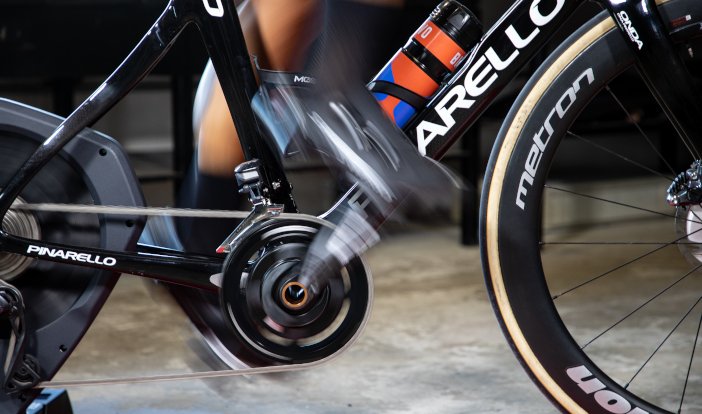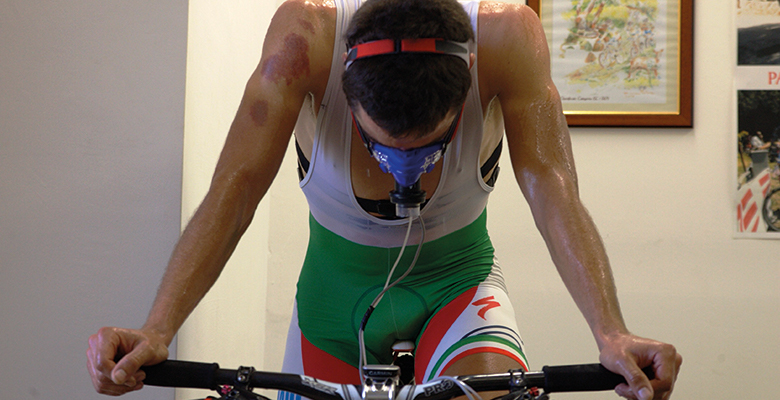We will now look at the various tests, the way they are performed and the meaning of the data obtained.
Marco Compri, technical coach of the Italian Cycling Federation and head of the training projects at Bikevo, explains us the correct way to train for cycling.
RELATIONSHIP BETWEEN POWER – CADENCE
A test can be used to show the relationship between power and cadence. It also provides us with the cyclist’s maximum force and corresponding cadence. After a good warm-up, the protocol foresees 5 maximum effort tests of 5-8”, with 3’ of recovery between one test and the other, using different gears, for instance 53:12 – 15 – 17 and 39:15-19 (or different cadences, indicatively 70-90-110-130-150 rpm, if an isokinetic ergometer is used).
Obviously, if different gears are used and you want to compare the curves of the two different tests it is necessary to standardize the peaks of the rpm by calculating the watt, before comparing them.
During the test, the cyclist will be asked to perform at maximum effort, meaning the maximum mechanical power possible while remaining seated.
WINGATE 30”
The Wingate test of 30 seconds allows us to analyze the anaerobic lactic capacity of the cyclist and to obtain the average maximum power, expressed in watt and as performed by the cyclist during the test. After recovering well from the first test, this test foresees the subject cycling for 30 seconds at maximum intensity while seated and with a cycling cadence at which, during the power – cadence test, the greatest power was reached.
INCREMENTAL TEST
Protocol: 6 ‘at 3w/kg (men) and 2,8w/kg women, to then be increased with 10 watt every 60 seconds until exhaustion. The cyclist is free to choose the cadence, if it can be maintained constantly and it lies between 85 and 95 rpm (from: Colli, personal communication).
The test ends when the test subject cannot maintain this effort anymore.
The power reached during this last step is the peak power (W max) which is linked to the corresponding heart rate and as such defines the peak heart rate (FC max).
Starting from these last power and heart rate values you can establish the training intensities by applying the following table (from: Collu, personal communication):
|
INTENSITY |
SYMBOL |
% MAX HR |
% MAX Power |
||
|
Maximum |
MAX |
100% |
100% |
||
|
VAM |
VAM |
95% |
98% |
92% |
97% |
|
Threshold |
THR |
90% |
95% |
80% |
90% |
|
Tempo ride |
TR |
85% |
90% |
75% |
80% |
|
Moderate |
MOD |
80% |
85% |
70% |
75% |
|
Endurance |
LNG |
70% |
80% |
60% |
70% |
|
Recovery |
REC |
60% |
70% |
30% |
60% |
Figure 5. Percentages referring to the mechanical peak power and max heart rate to be used in training
The acronyms used in the second colon of the table have the following meaning:
MAX: is the physiological limit of the athlete and depends on his VO2max. It reflects the incremental power test to exhaustion.
VAM (maximum aerobic speed): corresponds directly to the speed/power at which the cyclist reaches his Vo2max. It can be maintained only for short periods (6-8 minutes).
THR (anaerobic threshold): corresponds directly with the speed / power at which the cyclist starts to progressively accumulate lactic acid in his blood. It is used to raise the threshold or to improve the lactic acid clearing rate so that the cyclist can perform well even at higher levels of lactic acid.
TR (tempo ride): at this intensity, the workout can be sustained for more time (10-20’). It helps save glycogen at higher intensities and as such encourages the use of energy that comes from the oxidation of fats and spares the use of glucides.
MOD (moderate ride): as before, but at a lower intensity.
LNG (long ride): used to build aerobic capacity. This is useful when preparing for long course races (it builds resistance). The prevailing metabolism is the one of fat.
REC (slow ride): this intensity is the absolute minimum of the training zone. There are no specific stimulants to enhance performance. This is used as a warming up and cooling down or for recovery. It is an intensity that will never be used during a race.

Editorial Board
You might also be interested in


